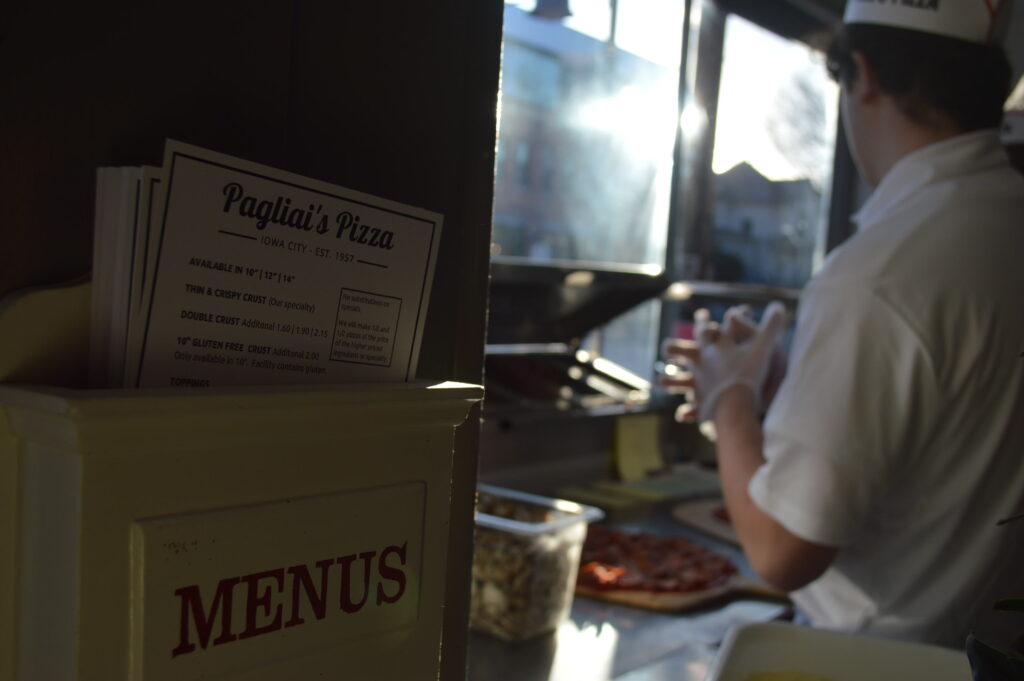
IOWA CITY, Iowa — Pagliai’s staff deftly serve pizza in the same building where Czech kolaches were undoubtedly served in the distant past.
That long history could eventually be marked in the form of a local landmark designation for the building most recognized in recent decades as the home of Pagliai’s Pizza in Iowa City.
Related: Commission to discuss future of building housing Pagliai’s Pizza
After a public hearing Feb. 8 that lasted about an hour, the Iowa City Historic Preservation Commission voted unanimously to designate the Slezak-Holub-Skarda Building, at 302-316 E. Bloomington St., as a local landmark.
The step is the first in a process that would protect the brick Italianate building and others in the complex — constructed between 1875 to 1880 — from future demolition. That designation also would make the building eligible for historic tax credits and other financial incentives for its upkeep.
Ten members of the public spoke, including building owner Gary Skarda, the only person who opposed the designation during the meeting. About 30 people attended the meeting, which Chairwoman Jordan Sellergren noted was the most she had seen during her time on the commission.

Property owner Gary Skarda speaks to the Iowa City Historic Preservation Commission on Feb. 8, 2024, at Iowa City City Hall. (photo/Cindy Hadish)
Skarda, the fifth generation owner, last year listed the building for $5 million, including 16 apartments and neighboring laundromat. He attended the meeting with his daughter, Victoria, 32, who does not own the property.
“Obviously, it’s been a big part of my life,” Skarda told the commission, recalling cleaning out the furnace and other maintenance tasks with his father in his youth.
In recent years, however, Skarda, who uses a walker, had an amputation, he noted, “and I can’t do the things I was once able to do.”
Designating the building as a local landmark would reduce the marketability of the building, he said.
“It’s privately owned and I don’t think it’s fair that the city will tell me what to do,” Skarda said, adding that the city could buy the property if they want to keep it as a local landmark.
The property has an assessed value of $1.5 million and its initial Zillow listing stated “NOT listed on Historic Register. PERFECT site for future development.”
That raised red flags for Sellergren and other preservationists, several of whom spoke at the meeting, thanking Skarda for his longtime stewardship of the building, but noting that the building is worth saving.
Ginalie Swaim, of Friends of Historic Preservation, detailed some of the building’s history, from the time it began as a Bohemian social hall in the upper level, known as Národní Síň, or National Hall, when one-fifth of Iowa City’s population was Bohemian, through its use as a hotel, eventually turned into apartments, a saloon and a grocery store, where changes were made in 1969 for Pagliai’s Pizza, then known as the Pizza Palace.

An early image shows the Národní Síň, or National Hall, then under the ownership of Joseph Holub.
Czech cultural and fraternal organizations, such as ZCBJ, used the upper level for dances and other social gatherings after first owner Joseph Slezak constructed the building, which reflected his immigrant roots in Bohemia, later part of the Czech Republic. It was later owned by his son-in-law, Joseph Holub.
The lower part became the first self-service grocery store in the area, then owned by Ralph and Viola Westcott.
A carriage house and a stable and feed barn were also part of the property, the latter of which became a garage and then a laundromat, which remains today.
Swaim noted that other hotels, saloons, livery stables and businesses existed at the same time in Iowa City.
“What’s unique is that this building served all of these purposes,” she said, noting that Slezak was adept in knowing what farmers in neighboring communities would want when they made the trek to Iowa City. “This building holds so many stories and so much meaning of this major part of American history and of local Iowa City history.”

Ornate corbels and dentil moulding can be seen on the building that houses Pagliai’s Pizza on Feb. 8, 2024, in Iowa City, Iowa. (photo/Cindy Hadish)
Author Marybeth Slonneger, who wrote a book about the Czech “Goosetown” neighborhood of Iowa City, said every time she goes past the building, she recalls the Goosetown residents she interviewed, who reminisced about dances and other events in the hall, including 25 cent Czech meals that included a beer.
In addition to the speakers, the commission received more than 40 emails in favor of designating the building as a local landmark.
Commission members cited the criteria needed to designate a building as a local landmark that include its significance to Iowa City culture and architecture; integrity of the structure, including intact corbels, dentil moulding and other original architectural details; association with events that have made a significant contribution to broad patterns of history, which includes its immigrant connection; and embodying distinctive characteristics of a period of construction.
The landmark designation proposal next goes to the Iowa City Planning and Zoning Commission and then to the City Council. Local landmarks are allowed in Iowa City without the owner’s consent, but the process requires a super-majority of the City Council for approval, or six of seven members.

The Holub Apartments still bear the name of the second owner of the complex, Joseph Holub. (photo/Cindy Hadish)
Regardless of the outcome, Anthony Fontanini, who owns Pagliai’s Pizza, said the business has a lease through September 2030, and plans on staying open through that time, and hopefully longer.
That sits well with customers, such as Tonja Robins of Iowa City.
“I love this place,” she said, while picking up a deluxe pizza that she planned to give to her brother-in-law when she visits him in Missouri. “I think it’s the best pizza in Iowa City.”
Customer Dean Kasper echoed her sentiments.
Kasper, 66, who attended school in Iowa City and now lives in Muscatine, said Pagliai’s was a favorite hangout spot after football games and other events.
“It would be such a heartache to see this place go,” he said.
MORE: 90-year-old Pagliai’s Pizza founder reminisces about restaurant






It would be nice to hear about this building being the first self service grocery store in the area. It was owned by Ralph and Viola Westcott. Emory J. Westcott. (Nephew)
Thanks Emory! It has quite a long history, but I’ll add that.
We lived a couple of blocks north on Linn and would buy penny candy when it was Tweedy’s grocery – up until about 1969.
What a wonderful memory, Wendy! Thank you for sharing it.
This building, and the varied uses it has had over the many years are part of the fabric of our town.
For the entirety of its life, it has held a meaningful place in Iowa City history. The location, surrounded by a neighborhood full of 100+ year old homes that tell the story of early Iowa City.
The early name, Slezak Hall was a hub for early Iowa Citians. Farmers came in from all over Johnson County bring their crops to town, staying at the hotel in the building there. The laundromat right next to the building now was a livery stables. The amazing thing is that so many of the old historic bits, pieces and details are still there, completely visible in this historic building.
I urge the city council to protect this building. It has another hundred or more years of life left to live as a part of our community.
Good points, Anne-Marie!
We have fond memories of a wonderful building. Val let us our first apartment. He and Gary were always very generous with us. We wish Gary and family well.
[…] Related: Iowa City takes first step to landmark Pagliai’s building […]
[…] More: Iowa City takes first step to landmark Pagliai’s building […]